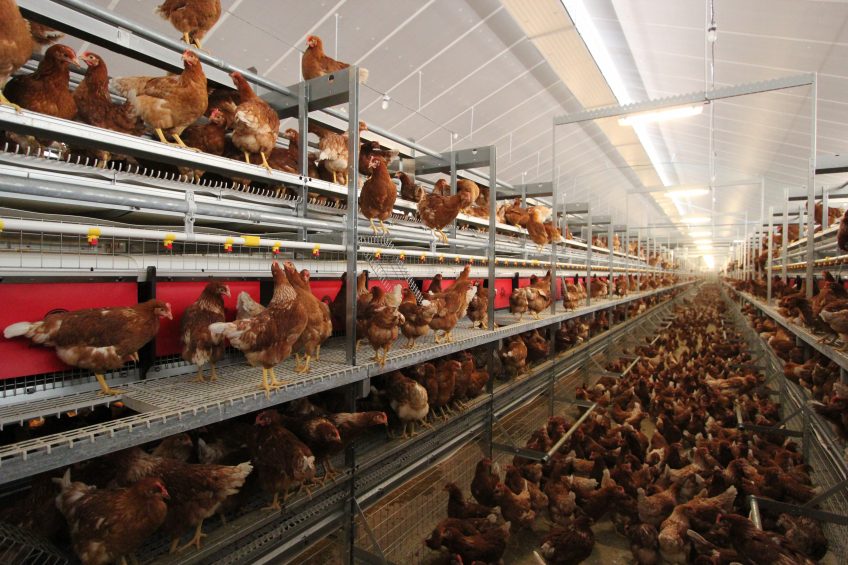The best non-cage alternative: The aviary

Worldwide, many egg producers will convert from conventional cages to aviary housing for laying hens in the following years. In 2015 and 2016 the majority of US grocers, restaurant chains, food services & hospitality, and other major food companies pledged to switch to the use of eggs coming from ‘cage-free’ laying hens. More recently the same trend can be seen in Latin-America and South Africa.
NGO’s, such as Humane Society International and Compassion in World Farming, spent tremendous effort and money on campaigning to achieve this movement. The main concerns against conventional cage housing are the limited amount of available space and lack of possibilities to perform highly-motivated natural behaviours. A similar widespread public concern and debate regarding laying hen welfare already resulted in a ban on conventional cages in the EU since 2012. As a consequence, millions of laying hens are or will be housed in other types of housing systems.
Aviary housing: Designed for farmers, inspired by layers
The aviary system is considered the best non-cage alternative to cage systems for large scale egg production as it allows housing of large flocks, ensuring excellent production results and low mortality, while offering more space and opportunities to perform highly-motivated behaviours.
The first aviaries were developed in the 1970’s and were developed further mainly in the Netherlands and Germany ever since. Four decades of developments and experience resulted in a variety of commercial aviary systems and knowledge on farm management.
Companies like Jansen Poultry Equipment (Barneveld, the Netherlands) have designed aviary systems that offer easy and practical management of both the system and the laying hens, ensuring a low amount of floor eggs. Provided management support gives farmers a head start and the confidence to be successful with their newly purchased aviary system.
Multi-tier system enables higher stocking densities
The aviary system is a so-called multi-tier system. The tiers are the most typical feature of the spacious character of the aviary and provide living space at several levels. Allowing hens to disperse across several levels, the tiers increase the total useable surface (max. 4 tiers according to EU Directive), thereby enabling higher stocking densities per m2 ground floor surface (approx. 18 hens/m2) compared to floor housing.
Freedom of movement
Hens can move freely through the henhouse and use the provided perches, feeding and drinking lines, and nest boxes at several tiers. This allows hens to perch and roost on aerial perches, perform nest seeking and egg-laying behaviours in communal nests, ‘forage’ for feed and water at feeders and drinker lines, and perform behaviours such as ground pecking, scratching and dustbathing. Even more foraging and other active behaviours can be performed if a non-compulsory covered veranda (wintergarden) or free-range is provided.
Better laying hen welfare
The ability to perform those behaviours makes it that aviary systems may offer a better laying hen welfare. Rules and regulations, such as the EU Directives and United Egg Producers Animal Husbandry Guidelines, guarantee space and opportunity to perform those behaviours, by stipulating maximum stocking densities, minimal perch and nest box space, and feeder and drinker space per bird.
Scientific research demonstrated that it should be encouraged to interconnect tiers with each other by ramps or approach perches. These features facilitate a continuous pathway for the hens to easily walk and jump towards the nests, feed and water and may prevent floor eggs. The floors of the tiers are preferably constructed of either rectangular plastic slats or welded wire mesh. Automated litter removal systems under the aviary prevent manure accumulation in the henhouse and contribute to cleaner environment, lower ammonia levels, lower fine dust emission, and reduce floor eggs.
Well begun is half done
Besides the development and experience with aviaries, more lessons need to be learned from the transition in the EU. Numerous farmers failed to be successful and even went bankrupt as they placed cage-reared pullets in aviaries. Such hens may lay up to 30% floor eggs, and result in many ‘dried-up hens’ with consequently a high mortality. It is utmost essential to rear pullets in a rearing systems that prepares young hens to be housed in aviaries during egg production. Aviary-rearing is characterized by offering platforms and tiers that train the pullets from a young age to go up in the system to reach water and feed.
“Selection of appropriate rearing and aviary system characteristics, management procedures and laying hen hybrid creates a better match between the laying hen and its environment. Ultimately this results in improved health and welfare of laying hens in commercial aviary systems, as well as better egg production and farm profitability” according to Dr Jasper Heerkens who obtained his PhD on assessment of the aviary system.














